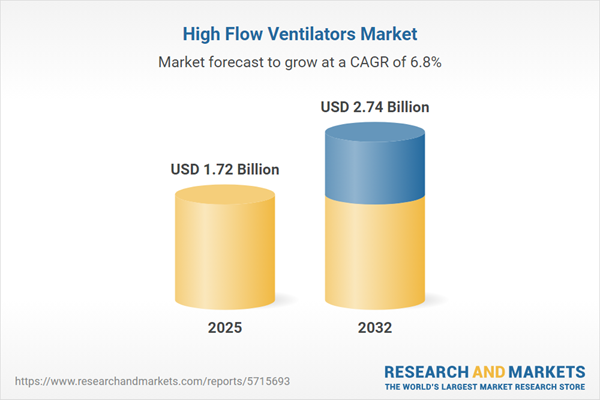Speak directly to the analyst to clarify any post sales queries you may have.
The high flow ventilators market is undergoing substantial change as healthcare organizations adopt advanced technologies and are prompted to update procurement approaches. Senior decision-makers must navigate evolving regulatory landscapes, manage risk exposure, and position their teams to deliver efficient, high-quality respiratory care.
Market Snapshot: High Flow Ventilators Market Size & Growth
The high flow ventilators market reached a value of USD 1.61 billion in 2024 and is projected to rise to USD 1.72 billion by 2025, with forecasts indicating it will climb to USD 2.74 billion by 2032. This growth reflects a compound annual growth rate (CAGR) of 6.81%. Sustained investment in healthcare infrastructure globally, alongside growing adoption of advanced respiratory therapies, continues to elevate demand. Manufacturers and healthcare providers are driving market momentum by integrating cutting-edge clinical devices and adjusting to regional regulation. Market participants focused on understanding dynamic local procurement and compliance requirements can maintain competitiveness and pivot toward integrated respiratory care solutions.
Scope & Segmentation: High Flow Ventilators Market Overview
- Product Types: Portable ventilators enhance mobility for treatment outside traditional clinical settings. Stationary and standalone units are essential for continuous support in intensive care environments.
- Operation Modes: Both invasive and non-invasive options are available, allowing providers to address a broad spectrum of patient requirements, such as intubated, mask-assisted, or nasal cannula therapies.
- Patient Types: Solutions are purpose-designed for adults, pediatric patients, and neonates, giving clinicians the flexibility to deliver acute interventions or manage extended therapy plans.
- End User Profiles: Devices are deployed in hospitals, private practices, public health facilities, and home care programs to ensure coverage of both acute and ongoing respiratory management.
- Flow Rates: Adjustable flow controls empower rapid clinical responses and maintain alignment with best practice care pathways.
- Regional Coverage: The market spans the Americas, Europe, Middle East & Africa, and Asia-Pacific, with unique patterns emerging in countries like China, India, Japan, and Australia where regulations and procurement preferences vary according to national priorities.
- Key Companies Analyzed: The report examines company strategies, product development, and positioning among Fisher & Paykel Healthcare, ResMed, Koninklijke Philips, GE, Hamilton Medical, Medtronic, Drägerwerk, Smiths Group, Vyaire Medical, and Vapotherm.
Key Takeaways for Healthcare Decision-Makers
- Incorporation of real-time sensor technology and advanced monitoring enables clinicians to personalize therapies and supports coordinated multidisciplinary care.
- Modular device design allows organizations to scale up or adapt platform configurations, supporting tailored solutions for evolving clinical practice requirements.
- Portable ventilators and customizable features facilitate smoother patient transitions, contributing to continuity between acute, post-acute, and home settings.
- Procurement focused on device reliability, robust durability, and measurable patient outcomes strengthens patient-centric program delivery.
- Anticipating changes in compliance standards and managing supply chains proactively builds resilience against future regulatory disruptions.
Tariff Impact: Navigating Regulatory and Supply Chain Challenges
Recent adjustments in U.S. tariff policies are prompting healthcare organizations to reevaluate supply chain structures for high flow ventilators. Diversifying suppliers and considering nearshoring strategies are practical steps that help reduce the risk of disruption and maintain consistency in care delivery. Close engagement with both regulatory agencies and principal vendors facilitates efficient sourcing and ensures organizations are positioned for compliance and operational stability.
Methodology & Data Sources
This study applies a triangulated methodology, drawing on peer-reviewed literature, regulatory input, direct engagement with manufacturers, and insights collected from clinicians, technologists, and supply chain leaders. These methods ensure findings are both comprehensive and relevant for executive decision-making in the high flow ventilators market.
Why This Report Matters
- Delivers actionable information to support procurement teams and guide capital investment decisions for advanced respiratory care technologies.
- Provides senior leaders with the tools to evaluate product innovation, manage operational challenges, and enhance organizational adaptability.
- Enables collaborative decision-making and resource optimization, increasing the value and effectiveness of respiratory care initiatives.
Conclusion
By drawing on up-to-date market insights, this report positions healthcare leaders to anticipate regulatory challenges, strengthen operational preparedness, and deliver advanced respiratory care across varied clinical settings.
Additional Product Information:
- Purchase of this report includes 1 year online access with quarterly updates.
- This report can be updated on request. Please contact our Customer Experience team using the Ask a Question widget on our website.
Table of Contents
3. Executive Summary
4. Market Overview
7. Cumulative Impact of Artificial Intelligence 2025
Companies Mentioned
The companies profiled in this High Flow Ventilators market report include:- Fisher & Paykel Healthcare Corporation Limited
- ResMed Inc.
- Koninklijke Philips N.V.
- General Electric Company
- Hamilton Medical AG
- Medtronic PLC
- Drägerwerk AG & Co. KGaA
- Smiths Group PLC
- Vyaire Medical Inc.
- Vapotherm Inc.
Table Information
| Report Attribute | Details |
|---|---|
| No. of Pages | 191 |
| Published | November 2025 |
| Forecast Period | 2025 - 2032 |
| Estimated Market Value ( USD | $ 1.72 Billion |
| Forecasted Market Value ( USD | $ 2.74 Billion |
| Compound Annual Growth Rate | 6.8% |
| Regions Covered | Global |
| No. of Companies Mentioned | 11 |









